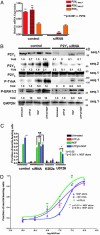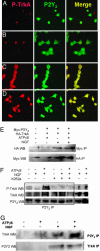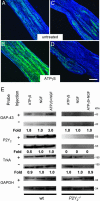P2Y2 receptor activates nerve growth factor/TrkA signaling to enhance neuronal differentiation
- PMID: 16365320
- PMCID: PMC1323158
- DOI: 10.1073/pnas.0505913102
P2Y2 receptor activates nerve growth factor/TrkA signaling to enhance neuronal differentiation
Abstract
Neurotrophins are essential for neuronal differentiation, but the onset and the intensity of neurotrophin signaling within the neuronal microenvironment are poorly understood. We tested the hypothesis that extracellular nucleotides and their cognate receptors regulate neurotrophin-mediated differentiation. We found that 5'-O-(3-thio)triphosphate (ATPgammaS) activation of the G protein-coupled receptor P2Y(2) in the presence of nerve growth factor leads to the colocalization and association of tyrosine receptor kinase A and P2Y(2) receptors and is required for enhanced neuronal differentiation. Consistent with these effects, ATPgammaS promotes phosphorylation of tyrosine receptor kinase A, early response kinase 1/2, and p38, thereby enhancing sensitivity to nerve growth factor and accelerating neurite formation in both PC12 cells and dorsal root ganglion neurons. Genetic or small interfering RNA depletion of P2Y(2) receptors abolished the ATPgammaS-mediated increase in neuronal differentiation. Moreover, in vivo injection of ATPgammaS into the sciatic nerve increased growth-associated protein-43 (GAP-43), a marker for axonal growth, in wild-type but not P2Y(2)(-/-) mice. The interactions of tyrosine kinase- and P2Y(2)-signaling pathways provide a paradigm for the regulation of neuronal differentiation and suggest a role for P2Y(2) as a morphogen receptor that potentiates neurotrophin signaling in neuronal development and regeneration.
Figures





Similar articles
-
P2Y2 and TrkA receptors interact with Src family kinase for neuronal differentiation.Biochem Biophys Res Commun. 2006 Sep 1;347(3):678-82. doi: 10.1016/j.bbrc.2006.06.141. Epub 2006 Jul 5. Biochem Biophys Res Commun. 2006. PMID: 16842754
-
Inhibition of apoptosis by P2Y2 receptor activation: novel pathways for neuronal survival.J Neurosci. 2006 Apr 5;26(14):3798-804. doi: 10.1523/JNEUROSCI.5338-05.2006. J Neurosci. 2006. PMID: 16597733 Free PMC article.
-
Regulation of PC12 cell survival and differentiation by the new P2Y-like receptor GPR17.Cell Signal. 2010 Apr;22(4):697-706. doi: 10.1016/j.cellsig.2009.12.006. Epub 2010 Jan 6. Cell Signal. 2010. PMID: 20056144
-
Mechanisms for inhibition of P2 receptors signaling in neural cells.Mol Neurobiol. 2005;31(1-3):65-79. doi: 10.1385/MN:31:1-3:065. Mol Neurobiol. 2005. PMID: 15953812 Review.
-
P2Y2 nucleotide receptor-mediated responses in brain cells.Mol Neurobiol. 2010 Jun;41(2-3):356-66. doi: 10.1007/s12035-010-8115-7. Epub 2010 Apr 13. Mol Neurobiol. 2010. PMID: 20387013 Free PMC article. Review.
Cited by
-
Interaction of purinergic receptors with GPCRs, ion channels, tyrosine kinase and steroid hormone receptors orchestrates cell function.Purinergic Signal. 2012 Mar;8(1):91-103. doi: 10.1007/s11302-011-9260-9. Epub 2011 Sep 2. Purinergic Signal. 2012. PMID: 21887492 Free PMC article.
-
Endogenous modulators of neurotrophin signaling: Landscape of the transient ATP-NGF interactions.Comput Struct Biotechnol J. 2021 May 7;19:2938-2949. doi: 10.1016/j.csbj.2021.05.009. eCollection 2021. Comput Struct Biotechnol J. 2021. PMID: 34136093 Free PMC article.
-
Nucleotide signaling in nervous system development.Pflugers Arch. 2006 Aug;452(5):573-88. doi: 10.1007/s00424-006-0067-4. Epub 2006 Apr 25. Pflugers Arch. 2006. PMID: 16639549 Review.
-
Selective loss of P2Y2 nucleotide receptor immunoreactivity is associated with Alzheimer's disease neuropathology.J Neural Transm (Vienna). 2008 Aug;115(8):1165-72. doi: 10.1007/s00702-008-0067-y. Epub 2008 May 28. J Neural Transm (Vienna). 2008. PMID: 18506388
-
P2Y receptors in Alzheimer's disease.Biol Cell. 2015 Jan;107(1):1-21. doi: 10.1111/boc.201400043. Epub 2014 Oct 13. Biol Cell. 2015. PMID: 25179475 Free PMC article. Review.
References
-
- Yamamoto, N., Tamada, A. & Murakami, F. (2002) Prog. Neurobiol. 68, 393-407. - PubMed
-
- Boglari, G. & Szeberenyi, J. (2001) Eur. J. Neurosci. 14, 1445-1454. - PubMed
-
- Gavazzi, I. & Cowen, T. (1996) J. Auton. Nerv. Syst. 58, 1-10. - PubMed
-
- Chuang, H. H., Prescott, E. D., Kong, H., Shields, S., Jordt, S. E., Basbaum, A. I., Chao, M. V. & Julius, D. (2001) Nature 411, 957-962. - PubMed
Publication types
MeSH terms
Substances
Grants and funding
- GM66232/GM/NIGMS NIH HHS/United States
- RR04050/RR/NCRR NIH HHS/United States
- GM007240/GM/NIGMS NIH HHS/United States
- R01 DA007315/DA/NIDA NIH HHS/United States
- NS052189/NS/NINDS NIH HHS/United States
- T32 DA007315/DA/NIDA NIH HHS/United States
- T32 GM007240/GM/NIGMS NIH HHS/United States
- HL58120/HL/NHLBI NIH HHS/United States
- P41 RR004050/RR/NCRR NIH HHS/United States
- DA07315-03/DA/NIDA NIH HHS/United States
- R01 NS052189/NS/NINDS NIH HHS/United States
- R01 NS051470/NS/NINDS NIH HHS/United States
- R01 GM066232/GM/NIGMS NIH HHS/United States
- NS051470/NS/NINDS NIH HHS/United States
- P01 HL058120/HL/NHLBI NIH HHS/United States
LinkOut - more resources
Full Text Sources
Molecular Biology Databases
Miscellaneous

